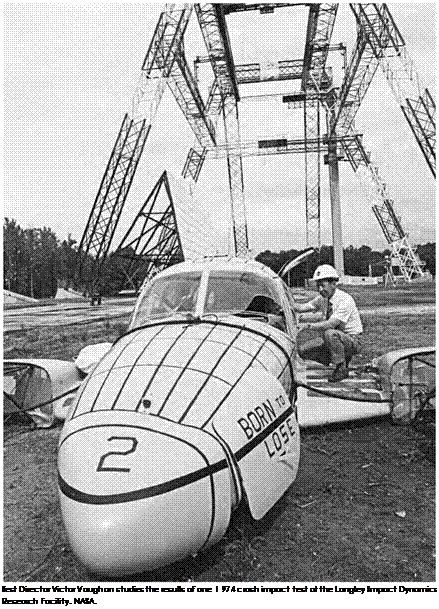Crash Impact Research
In support of the Apollo lunar landing program, engineers at the Langley Research Center had constructed a huge steel A-frame gantry structure, the Lunar Landing Research Facility (LLRF). Longer than a football field and nearly half as high as the Washington Monument, this facility proved less useful for its intended purposes than free-flight jet-and-rocket powered training vehicles tested and flown at Edwards and Houston. In serendipitous fashion, however, it proved of tremendous value for aviation safety after having been resurrected as a crash-impact test facility, the Impact Dynamics Research Facility (IDRF) in 1974, coincident with the conclusion of the Apollo program.[851]
 |
|
Over its first three decades, the IDRF was used to conduct 41 full – scale crash tests of GA aircraft and approximately 125 other impact tests of helicopters and aircraft components. The IDRF could pendulum-sling aircraft and components into the ground at precise impact angles and velocities, simulating the dynamic conditions of a full-scale accident
or impact.[852] In the first 10 years of its existence, the IDRF served as the focal point for a joint NASA-FAA-GA industry study to improve the crashworthiness of light aircraft. It was a case of making the best of a bad situation: a flood had rendered a sizeable portion of Piper’s single – and-twin-engine GA production at its Lock Haven, PA, plant unfit for sale and service.[853] Rather than simply scrap the aircraft, NASA and Piper worked together to turn them to the benefit of the GA industry and user communities. A variety of Piper Aztecs, Cherokees, and Navajos, and later some Cessna 172s, some adorned with colorful names like "Born to Lose,” were instrumented, suspended from cable harnesses, and then "crashed” at various impact angles, attitudes, velocities, and sink-rates, and against hard and soft surfaces. To gain greater fidelity, some were accelerated during their drop by small solid-fuel rockets installed in their engine nacelles.[854]
Later tests, undertaken in 1995 as part of the Advanced General Aviation Transport Experiment (AGATE) study effort (discussed subsequently), tested Beech Starship, Cirrus SR-20, Lear Fan 2100, and Lancair aircraft.[855] The rapid maturation of computerized analysis programs led to its swift adoption for crash impact research. In partnership with NASA, researchers at the Grumman Corporation Research Center developed DYCAST (DYnamic Crash Analysis of STructures) to analyze structural response during crashes. DYCAST, a finite element program, was qualified during extensive NASA testing for light aircraft component testing, including seat and fuselage section analysis, and then made available for broader aviation community use in 1987.[856] Application of computa
tional methodologies to crash impact research expanded so greatly that by the early 1990s, NASA, in partnership with the University of Virginia Center for Computational Structures Technology, held a seminal workshop on advances in the field.[857] Out of all of this testing came better understanding of the dynamics of an accident and the behavior of aircraft at and after impact, quantitative data applicable to the design of new and more survivable aircraft structures, better seats and restraint systems, comparative data on the relative merits of conventional versus composite construction, and computational methodologies for evermore precise and informed analysis of crashworthiness.










